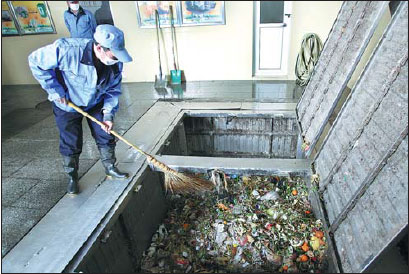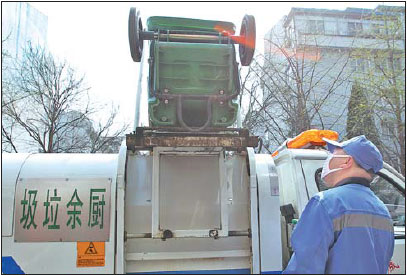Waste management in capital rises up municipal priority list
Improved collection systems, new technology tackle growing issue for city's future, Li You reports.
Dealing with household waste is a topic that not often considered by people living in cities. People know how waste is generated, but don't know where it goes after being put into garbage cans.
With around 22 million permanent residents, Beijing can generate around 23,800 metric tons of household waste every day. Household waste increases every year, according to the Beijing Municipal Commission of City Management.
Beijing categorizes household waste into three major types: recyclable waste, kitchen waste and everything else.
Different from construction or industrial waste, household waste involves separating recyclables - such as bottles, cans, clothing, packaging and paper - from kitchen waste and hazardous waste.
"Beijing considers the disposal of household garbage a crucial project concerning people's livelihood," said Lin Jinwen, director of the Division for Environmental and Sanitary Facilities at the Beijing Municipal Commission of City Management.
"The city has set the goal of detailed management with the goals of garbage reduction, garbage-to-resource transformation and harm-free disposal."
Means of disposal
Currently, there are three main disposal methods to deal with household waste: incineration, sanitary landfill and bio-disposal.
Ten years ago, about 10 percent of household waste was disposed of through incineration. At present, 42 percent of household waste is disposed of by incineration, 37 percent by sanitary landfill, 21 percent by bio-disposal, according to Lin Jinwen.
"Incineration can help to reduce the amount of garbage by 80 percent and increase resource utilization by generating electricity and supplying heat for residents, as well as saving land," Lin said.
In 2016, the total power generated by landfill gas and incineration reached 740 million kilowatt-hours, saving about 300,000 tons of standard coal.
Before 2000, most household waste in Beijing was disposed of in sanitary landfills, said Feng Xiangpeng, acting director of the Division for Solid Waste Management at the Beijing Municipal Commission of City Management.
As an international metropolis, Beijing's land resources are becoming increasingly scarce. Along with the other shortcomings, the landfill method can no longer meet demand, according to Feng.
"We adjusted the disposal methods and expanded the management and input of waste incineration and bio-disposal," Feng said.
In the past five years, four waste incineration plants have been completed. As of the end of 2016, Beijing had 26 waste incineration plants in total.
The plants are now providing a daily disposal capacity of 24,300 tons, in which the capacity for incineration and bio-disposal has reached 15,200 tons per day.
By the end of 2020, the city's daily garbage creation is expected to reach 28,000 tons.
Sorting policies
The annual social cost of Beijing burning household trash is about 2 billion yuan ($294 million), according to a report released in March by the Beijing Academy of Development and Strategy.
However, the academy, which is affiliated with Renmin University of China, estimates this could be cut by as much as 64 percent by revamping waste treatment and introducing a classification system, showing the necessity for trash sorting.
Beijing has been carrying out its waste-sorting program since 1996. Since 2010, the program has been rolled out in 3,759 residential communities in Beijing, accounting for 80 percent of all residential communities and covering more than 8 million residents.
"In the next step, Beijing's government will aim to separate dry garbage from wet garbage and improve the amount of recycled resources," Lin said.
He said Beijing will release a number of supporting policies such as "bringing clean vegetables to Beijing", "banning over-packaging and single-use products", "encouraging the exchange of used goods" and a "clean dishes campaign in restaurants".
"Waste sorting is a process of residents building new habits," said Feng. The Beijing government employed more than 20,000 instructors to assist residents in waste sorting practices.
"I used to sort out the waste from my home carefully. But one day, I saw a truck mix the waste from waste sorting cans all together and carry them away, I felt it was a waste of time to do so," said a student in Beijing, surnamed Cao.
"But if the government can implement harsher policies and respect our efforts in waste sorting, it would be appreciated."
To tackle the problem, China has recently announced plans to further promote its household waste sorting in 46 major cities, in which all public institutes and companies are required to separate hazardous waste, kitchen waste and recyclable materials by 2020.
Beijing, Shanghai, Tianjin and 43 other major cities, including the capitals of all provinces, are involved in the plan.
By then, specific policies, laws and regulations will be implemented to push mandatory trash sorting forward, and the recycling rate will grow to at least 35 percent in these cities, according to Feng Liang, a senior official at the National Development and Reform Commission, China's top economic planner.
Contact the writer at liyou@chinadaily.com.cn
|
A worker clears kitchen waste collected from communities near the Xibianmen garbage storage building.Photos By Zhang Wei / China Daily |
|
Special garbage trucks labeled for "kitchen waste" are used to transport and dump refuse in Beijing. |
|
Staff members of the Majialou garbage transferring station in Beijing's Fengtai district supervise garbage processing on screen. |
(China Daily 04/13/2017 page5)

















